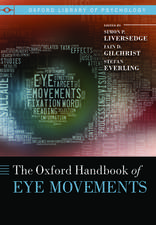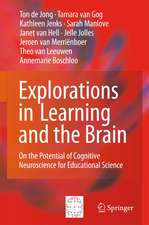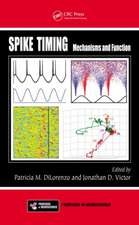Aging and Recovery of Function in the Central Nervous System
Autor Stephen W. Scheffen Limba Engleză Paperback – oct 2011
Preț: 365.10 lei
Preț vechi: 384.31 lei
-5% Nou
Puncte Express: 548
Preț estimativ în valută:
69.87€ • 75.87$ • 58.69£
69.87€ • 75.87$ • 58.69£
Carte tipărită la comandă
Livrare economică 23 aprilie-07 mai
Preluare comenzi: 021 569.72.76
Specificații
ISBN-13: 9781461296805
ISBN-10: 1461296803
Pagini: 240
Ilustrații: XIV, 222 p. 41 illus.
Dimensiuni: 152 x 229 x 13 mm
Greutate: 0.33 kg
Ediția:1984
Editura: Springer Us
Colecția Springer
Locul publicării:New York, NY, United States
ISBN-10: 1461296803
Pagini: 240
Ilustrații: XIV, 222 p. 41 illus.
Dimensiuni: 152 x 229 x 13 mm
Greutate: 0.33 kg
Ediția:1984
Editura: Springer Us
Colecția Springer
Locul publicării:New York, NY, United States
Public țintă
ResearchCuprins
1 Longevity, Disease, and Autoimmune Reactions following Focal Cortical Injuries.- 1. Introduction.- 2. Longevity.- 3. Disease Profiles.- 4. Neuron-Binding Antibodies.- 5. Conclusions.- References.- 2 Aging and Hypothalamic Regulation of Metabolic, Autonomic, and Endocrine Function.- 1. Introduction.- 2. Structure and Function of the Hypothalamus.- 3. Hypothalamic Theories of Aging.- 4. Effects of Hypothalamic Damage.- 5. Aging-Hypothalamic Damage Comparisons.- 6. Overview and Summary.- References.- 3 Morphological Measurements in the Aging Rat Cerebral Cortex.- 1. Introduction.- 2. Neuronal and Glial Cell Number Changes during Aging.- 3. Aging and Impoverishment.- 4. Summary.- References.- 4 Morphologic Aspects of Brain Damage in Aging.- 1. Introduction.- 2. Reactive Synaptogenesis in Young Adult Animals.- 3. Normal Anatomy of the Aged Hippocampus.- 4. Reactive Synaptogenesis in the Dentate Gyrus of Aged Animals.- 5. Adrenergic Sprouting in the Limbic System of Aged Rats.- 6. Possible Mechanisms for Reduced Sprouting Capacity.- 7. Conclusion.- References.- 5 Relationship of the Raphe and Suprachiasmatic Nuclei to Serotonin Facilitation of Cyclic Reproductive Functions in Aging Female Rats.- 1. Introduction.- 2. Temporal Patterns of Hypothalamic 5-HT and Cyclic Reproductive Function.- References.- 6 Behavioral Consequences of Neuronal Plasticity following Injury to Nigrostriatal Dopaminergic Neurons.- 1. Introduction.- 2. Approaches to Studying the Neural Events Mediating Behavioral Recovery.- 3. Inattention to Stimuli.- 4. Neglect after Nigrostriatal Injury as a Model System.- 5. Neural Events Contributing to Recovery of Sensorimotor Functions.- 6. Future Directions.- 7. Conclusions.- References.- 7 Do Rats Have Hypotheses? A Developmental and Means-Ends Analyses Approach to Brain Damage, Recovery of Function, and Aging.- 1. Introduction.- 2. Methods.- 3. Results.- 4. Discussion.- References.- 8 Age, Brain Damage, and Behavioral Recovery.- 1. Introduction.- 2. Spatial Alternation Learning.- 3. Emotional Reactivity.- 4. DRL-20 Performance.- 5. Discussion.- References.- 9 Age and Recovery from Brain Damage: A Review of Clinical Studies.- 1. Functional Plasticity after Early Brain Injury.- 2. Head Injury through the Lifespan.- 3. Pathophysiology of Closed-Head Injury in Relation to Age.- 4. Effects of Age on Outcome after Head Injury.- 5. Early and Late Neurobehavioral Effects of Head Injury.- 6. Directions for Future Research.- References.- 10 Recovery of Function in Senile Dementia of the Alzheimer Type.- 1. Introduction.- 2. Alzheimer’s Disease: The Clinical and Biochemical Problem.- 3. Behavioral Strategies for Cognitive Deficits of Alzheimer’s Disease.- 4. Pharmacologic Intervention in Alzheimer’s Disease.- 5. Cholinergic Systems, Trophic Substances, and Potential Therapies for Alzheimer’s Disease.- 6. Pharmacologic Enhancement of a Trophic Factor Effect.- References.













